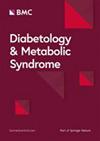The relation of mTOR with diabetic complications and insulin resistance in patients with type 2 diabetes mellitus
IF 3.4
3区 医学
Q2 ENDOCRINOLOGY & METABOLISM
引用次数: 0
Abstract
Dysregulation of the mechanistic target of rapamycin (mTOR) has been related to several metabolic conditions, notably obesity and type 2 diabetes (T2DM). This study aimed to evaluate the role of mTOR in patients with T2DM, and its relationship with insulin resistance and microvascular complications. This case-control study was conducted on 90 subjects attending the Outpatient Internal Medicine Clinic in Damanhur Teaching Hospital. Subjects were divided into 3 groups, Group I: 20 healthy controls, Group II: 20 subjects with T2DM without complications, and Group III: 50 subjects with T2DM with microvascular complications. An Enzyme-linked immunosorbent assay was used to measure serum mTOR levels. T2DM and diabetic complications were defined according to the diagnostic criteria of the American Diabetes Association. The results revealed significant positive correlations to HbA1c (r = 0.530, P < 0.001), fasting glucose (r = 0.508, P < 0.001), and HOMA- IR (r = 0.559, P < 0.001), and a significant negative correlation to eGFR (r=-0.370, P = 0.002). Multivariate analysis revealed an independent association of mTOR and HbA1c values with the presence of microvascular complications. The prediction of microvascular complications was present at a cutoff value of 8 ng/ml mTOR with a sensitivity of 100% and specificity of 95% with an AUC of 0.983 and a p-value < 0.001. mTOR is a prognostic marker of diabetic microvascular and is associated with insulin resistance in patients with T2DM. The study was conducted following the Declaration of Helsinki, and approved by the Ethics Committee of Alexandria University (0201127, 19/7/2018).mTOR 与 2 型糖尿病患者的糖尿病并发症和胰岛素抵抗的关系
雷帕霉素机制靶标(mTOR)的失调与多种代谢疾病有关,尤其是肥胖和 2 型糖尿病(T2DM)。本研究旨在评估 mTOR 在 T2DM 患者中的作用及其与胰岛素抵抗和微血管并发症的关系。这项病例对照研究的对象是在达曼胡尔教学医院内科门诊就诊的 90 名受试者。受试者被分为三组,第一组:20 名健康对照组;第二组:20 名患有 T2DM 且无并发症的受试者;第三组:50 名患有 T2DM 且有微血管并发症的受试者。采用酶联免疫吸附法测定血清中的 mTOR 水平。T2DM和糖尿病并发症是根据美国糖尿病协会的诊断标准定义的。结果显示,mTOR与HbA1c(r=0.530,P<0.001)、空腹血糖(r=0.508,P<0.001)和HOMA- IR(r=0.559,P<0.001)呈显著正相关,与eGFR(r=-0.370,P=0.002)呈显著负相关。多变量分析表明,mTOR 和 HbA1c 值与微血管并发症的发生存在独立关联。mTOR 是糖尿病微血管的预后标志,与 T2DM 患者的胰岛素抵抗有关。该研究遵照《赫尔辛基宣言》进行,并获得了亚历山大大学伦理委员会的批准(0201127,19/7/2018)。
本文章由计算机程序翻译,如有差异,请以英文原文为准。
求助全文
约1分钟内获得全文
求助全文
来源期刊

Diabetology & Metabolic Syndrome
ENDOCRINOLOGY & METABOLISM-
CiteScore
6.20
自引率
0.00%
发文量
170
审稿时长
7.5 months
期刊介绍:
Diabetology & Metabolic Syndrome publishes articles on all aspects of the pathophysiology of diabetes and metabolic syndrome.
By publishing original material exploring any area of laboratory, animal or clinical research into diabetes and metabolic syndrome, the journal offers a high-visibility forum for new insights and discussions into the issues of importance to the relevant community.
 求助内容:
求助内容: 应助结果提醒方式:
应助结果提醒方式:


